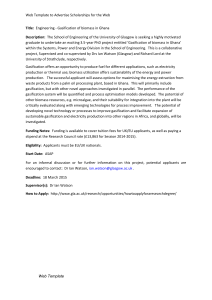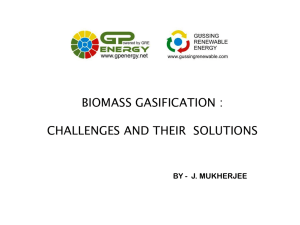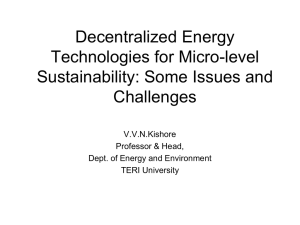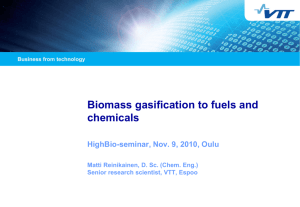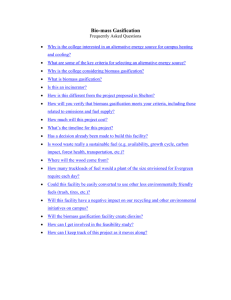1-ESCI 1131-2010-Course Syllabus
advertisement
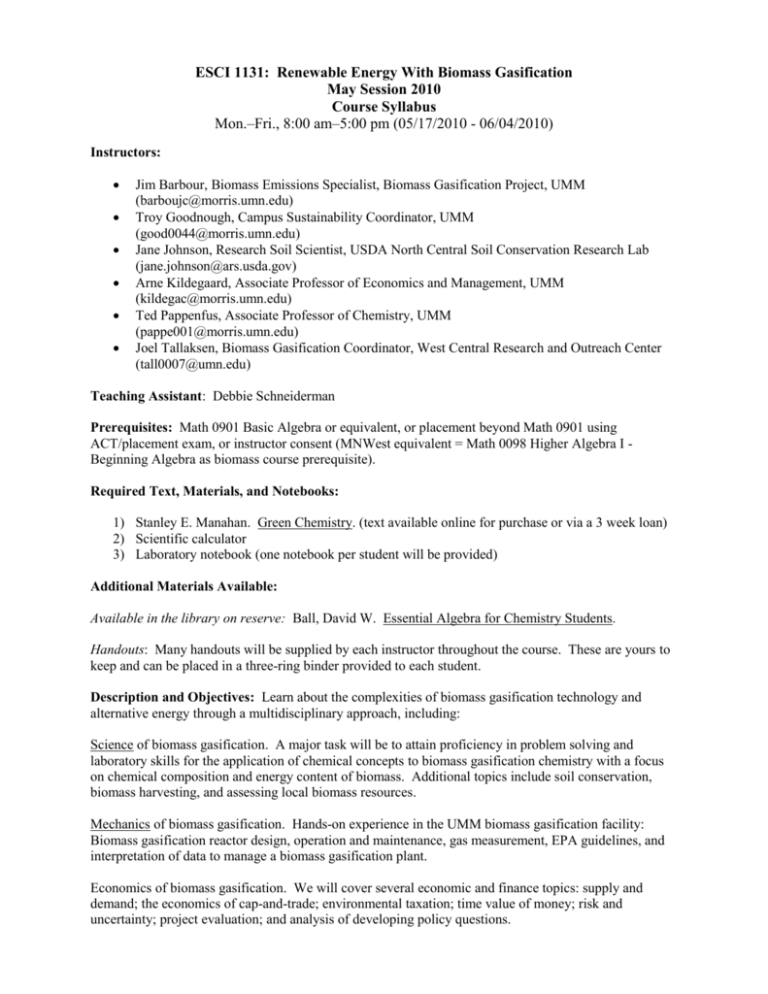
ESCI 1131: Renewable Energy With Biomass Gasification May Session 2010 Course Syllabus Mon.–Fri., 8:00 am–5:00 pm (05/17/2010 - 06/04/2010) Instructors: Jim Barbour, Biomass Emissions Specialist, Biomass Gasification Project, UMM (barboujc@morris.umn.edu) Troy Goodnough, Campus Sustainability Coordinator, UMM (good0044@morris.umn.edu) Jane Johnson, Research Soil Scientist, USDA North Central Soil Conservation Research Lab (jane.johnson@ars.usda.gov) Arne Kildegaard, Associate Professor of Economics and Management, UMM (kildegac@morris.umn.edu) Ted Pappenfus, Associate Professor of Chemistry, UMM (pappe001@morris.umn.edu) Joel Tallaksen, Biomass Gasification Coordinator, West Central Research and Outreach Center (tall0007@umn.edu) Teaching Assistant: Debbie Schneiderman Prerequisites: Math 0901 Basic Algebra or equivalent, or placement beyond Math 0901 using ACT/placement exam, or instructor consent (MNWest equivalent = Math 0098 Higher Algebra I Beginning Algebra as biomass course prerequisite). Required Text, Materials, and Notebooks: 1) Stanley E. Manahan. Green Chemistry. (text available online for purchase or via a 3 week loan) 2) Scientific calculator 3) Laboratory notebook (one notebook per student will be provided) Additional Materials Available: Available in the library on reserve: Ball, David W. Essential Algebra for Chemistry Students. Handouts: Many handouts will be supplied by each instructor throughout the course. These are yours to keep and can be placed in a three-ring binder provided to each student. Description and Objectives: Learn about the complexities of biomass gasification technology and alternative energy through a multidisciplinary approach, including: Science of biomass gasification. A major task will be to attain proficiency in problem solving and laboratory skills for the application of chemical concepts to biomass gasification chemistry with a focus on chemical composition and energy content of biomass. Additional topics include soil conservation, biomass harvesting, and assessing local biomass resources. Mechanics of biomass gasification. Hands-on experience in the UMM biomass gasification facility: Biomass gasification reactor design, operation and maintenance, gas measurement, EPA guidelines, and interpretation of data to manage a biomass gasification plant. Economics of biomass gasification. We will cover several economic and finance topics: supply and demand; the economics of cap-and-trade; environmental taxation; time value of money; risk and uncertainty; project evaluation; and analysis of developing policy questions. Attendance: Attendance is important! It is assumed that every student is present at every lecture, lab, or other course activity. Therefore YOU ARE RESPONSIBLE for all announcements and for all material covered in class. Each day you should have available a calculator, notebook, and writing utensil. Disabilities: Students with a disability that may require modification in seating, or other class requirements should contact an instructor or Disabilities Services at 362 Briggs Library, 589-6163. Courtesy in the Lecture and Lab: Please be courteous of your instructor and your fellow students: Arrive ON TIME! Turn off your cell phone before entering the lecture room or lab. Stop talking when your instructor begins to lecture, and do not talk during lectures. Pay attention during lecture: don’t read the paper, work crossword puzzles, etc. Laptop computers and other portable technologies should be used in class only as learning-facilitation tools. During class, it is not acceptable to play games, answer email, surf the web, answer cell phones, text message, or engage in other non-class-related activities. Assessment: Each lecture will include short problems or quizzes covering material from the most recent lecture(s). Each experiment in lab will also have an associated lab report. On the last day of class you will be given a final survey which will quiz your knowledge on the important concepts/topics in the course. You will also give a short presentation as part of a group activity on the last day of the course. Grading: Your grade for this course will be based on your performance in the classroom and in the laboratory. For more details see the grading addendum. Any assignments turned in late will lose 20% per day late until there are no longer any points available. Your course percentage will be a weighted average of the following components: Course Component (Instructor(s) grading the component) Economics (Kildegaard) Mechanics (Barbour, Goodnough, Tallaksen) Science (Johnson, Pappenfus, Tallaksen) Final Presentation (All) Final Survey (All) Total Percent % of grade 15 35 35 10 5 100 Grade Assignments: Letter grades are assigned based on your course percentage. If your final overall score is 90% or better, you are guaranteed a grade of A (A or A-); 80% or better to get at least a grade of B (B+, B, or B-), and 70% or better to get at least a grade of C (C+, C, or C-), etc. Actual cut-off %'s may be lower, but not higher. The complete University Senate grading policy can be found on the web at: http://www.fpd.finop.umn.edu/groups/senate/documents/policy/gradingpolicy.html WebVista: A course website will be available on WebVista. WebVista is a course management software that enables instructors to manage course materials. The primary role of WebVista in this course will be to post grades, syllabi, announcements, etc. The web address is http://webvista.umn.edu. Click on WebVista C for direct access. If you have difficulties using the program, you may have to make changes to your browser (go to http://webvista.umn.edu/browser/). Email: Check your email daily for class announcements and other University related announcements. Cheating: The UMM student conduct code prohibits scholastic dishonesty. Any evidence of such misconduct will be taken seriously and dealt with through the appropriate channels. This policy can be found on the web at: http://www.morris.umn.edu/services/reslife/slhandbook.html Notes: This workforce solution was funded by a grant awarded under Workforce Innovation in Regional Economic Development (WIRED) as implemented by the U.S. Department of Labor’s Employment and Training Administration. The solution was created by the grantee and does not necessarily reflect the official position of the U.S. Department of Labor. The Department of Labor makes no guarantees, warranties, or assurances of any kind, express or implied, with respect to such information, including any information on linked sites and including, but not limited to, accuracy of the information or its completeness, timeliness, usefulness, adequacy, continued availability, or ownership. This solution is copyrighted by the institution that created it. Internal use by an organization andfor personal use by an individual for non-commercial purposes is permissible. All other uses require the prior authorization of the copyright owner.


